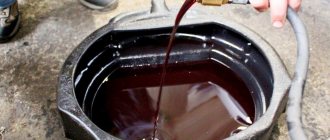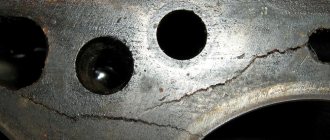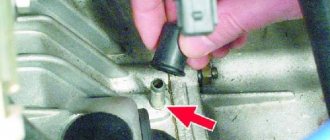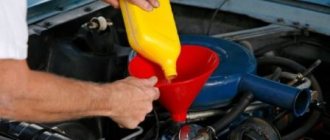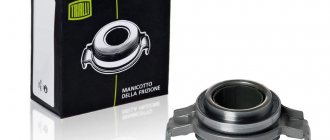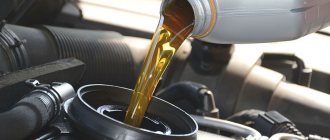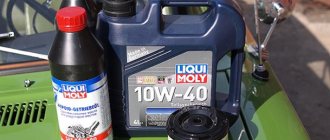An oil leak from under the cylinder head is an indicator of a cylinder seal failure, which can lead to serious consequences, including major engine overhauls. The head gasket is considered a rather vulnerable structural element and requires special attention. The appearance of oil from under the head indicates the need to urgently determine the cause of this phenomenon and take measures to eliminate it.
Most motorists are faced with the problem of high oil consumption in the engine.
The essence of the problem
Between the cylinder block and its head (cylinder head) there is a gasket responsible for the tightness of the structure. It is not possible to visually assess its condition, so oil leakage is an important indicator of a seal failure. When oil leaks from under the cylinder head, there can be several reasons: from insufficient tightening of the bolts to the destruction of the gasket or the appearance of cracks on the head itself. If damage to the gasket is detected, it is advisable to entrust its replacement to professionals, as this requires appropriate skills.
If there is an oil leak, it can seep into the cooling system. The fact of this phenomenon can be easily verified by looking into the radiator or expansion tank. Oil ingress will result in oil spots on the surface of the coolant. Oil leakage is dangerous because uncontrolled loss of oil volume impairs protective functions and leads to engine wear. Oil leakage can also be directed into the cylinders. Spark plugs often become oily. In this case, you can expect damage not only to the gasket, but also to the oil scraper tracks or valve seals.
Why is oil leaking from the engine oil filter?
To correct this problem, work begins with dismantling the filter part. Then a visual assessment of the condition is carried out. Pay attention to mechanical damage - the part may be broken or damaged. If the condition is unsatisfactory, replacement is required. If there are no such defects, lubricate the rubber component with engine oil and return everything to its place. Tighten the fasteners tighter.
If oil is leaking from a diesel engine, there may be obvious reasons:
- breakdown of the cylinder head gasket;
- wear of the crankshaft oil seal;
- fluid leakage from under the filter;
- failure of valve stem seals;
- occurrence of rings;
- piston wear.
Unobvious sources of the problem include regular engine overheating, wear of turbine bearings (and seals), breakdowns in the fuel system, failure of the high-pressure fuel pump, failure of crankcase ventilation, and excess pressure of crankcase gases.
Impact of gasket defects
Most often, leaks occur in places where gaskets are installed.
Defects in cylinder head gaskets tend to result in leakage of oil, coolant or exhaust gases. Coolant leakage may occur on the outer surface of the structure; into the combustion chamber or oil system. The exhaust gas mixture can penetrate from one chamber to the next through a damaged partition into the cooling system. An oil leak is detected by traces on the outer surface, in the coolant, or by characteristic signs of entry into the cylinder.
A sure sign of a leak is the penetration of gases under the rim of the combustion chamber. An indicator of such damage are traces of blackening on the metal of the edging or on the adjacent areas of the gasket. The gasket material at the point where superheated gases enter is subject to active thermal destruction, which causes its destruction. At the same time, uniform darkening over the entire surface does not indicate a destructive effect.
Causes of damage to the lining
- Gases. Exhaust gases enter the area between the 2nd and 3rd cylinders. The gasket elastomer is deformed in the area of the coolant passage hole. This problem may be caused by the following: loose bolts; dropped cylinder liner; deformed parts; rough surface of spare parts; incorrectly adjusted start of fuel intake.
- The section of the hole for the pusher has delaminated. This may be due to: high loads on the motor; incorrect installation of the sleeve protrusion; uneven surface of the cylinder head.
- Overheating. Thermal overheating of the lining causes the seals to rupture. Overheating can occur due to a low octane index of the fuel, increased compression levels, or incorrectly adjusted spark plugs. Typically, overheating causes the gasket material to swell near the antifreeze passage holes.
- Flow of lubricant over the surface. Typically, pads are used that consist of metal and elastomer. Grooves are formed in the cylinder head, which are sealed with gasket seals. If these grooves are not properly cleaned of dirt or carbon deposits, an oil leak occurs. If installation errors are made, the elastomer layer may become wrinkled. This increases the chance of depressurization.
- Installation errors. Most often, lubricant leaks from under the gasket due to poorly tightened bolts, so it is advisable to repair or change the lining in a specialized car service center whose employees you can rely on.
- Incorrect choice of pad. Often the dimensions of the combustion chamber do not correspond to the size of the lining. An unsuitable gasket, if installed in the motor, will soon be damaged. Also, you should not install products that are manufactured by an unknown company. The oil will continue to leak even after replacement if you use a low-quality lining.
An oil leak is considered a fairly significant problem. Having identified it, you need to immediately take measures to correct it. All procedures are best carried out in car services. This is especially true if you, for example, are a fragile girl in stiletto heels. Do not touch the power unit, much less dismantle it. This can lead to complete breakdown of the vehicle. It will be necessary to carry out major repairs, which are very expensive. It’s easier to immediately pay specialists to fix the oil leak. This way you will spend much less of your own money. The main thing is not to ignore the malfunction. A minor problem can very likely turn into a serious breakdown that makes the vehicle impossible to operate.
A very unpleasant moment, familiar to many motorists, is when oil leaks from under the cylinder head. Many, especially novice car owners, do not pay attention to this, especially if only a couple of drops are leaking. However, if you leave this whole thing to chance, then a harmless “couple” of drops will soon turn into a trickle, and after some time there will be no oil left in the engine at all.
Types of Gasket Defects
Oil leakage from under the cylinder head is most often caused by damage to the gasket. The main reasons for its destruction can be: rupture by gases; overheat; coolant leak; mechanical influences.
Violation of integrity by gases. One of the common causes of damage is associated with strong penetration of the exhaust gas composition between the second and third cylinders (during the exhaust cycle). The elastomer of the gasket is destroyed in the area of the hole for the passage of the coolant. This phenomenon is caused by the following reasons: the penetration of gases into the cooling liquid due to poor tightening of the bolts; lowering the cylinder liner; deformation of elements; surface roughness of parts; Incorrect adjustment of the start of fuel supply.
Oil is leaking from the engine - causes of leakage, ways to fix the problem
Most automotive components and assemblies operate stably, among other things, thanks to lubricating fluids. This is of great importance for the “heart” of the car.
The tightness of the internal combustion engine is ensured by special seals (cuffs, gaskets, seals, etc.).
Due to the natural or premature wear of these elements (this is important, for example, if the quality is initially low), there is a high probability of depressurization.
It is important to fix such a malfunction immediately, but first you need to find the source of the leak. Often replacing a leaky sealing part solves the problem, but this does not always help. If timely measures are not taken, the engine will quickly wear out and will require expensive repairs or replacement. Identifying the cause of the leak will allow you to replace faulty parts, select the correct automotive chemicals and clean the ventilation.
Find out the cost of car engine diagnostics online in 3 minutes
Don't waste your time - use the Uremont search and get offers from nearby services with specific prices!
The essence of the breakdown
As we said earlier, there is a sealing element between the head and the block.
- Poorly tightened bolts. This usually occurs due to poor quality repairs.
- Deformation of the gasket itself (unfortunately, no one is immune from defects).
It is not always the gasket that causes an oil leak from under the cylinder head. Reason #2 is engine overheating. As a result, the surface of the cylinder head becomes uneven. Even after replacing the sealing element, oil leakage from under the cylinder head does not stop. It is necessary to grind the cylinder head or replace it with a new one. The latter option is often applied to heads that have cracks. There is no way to repair them. The structure has already lost its strength and tightness.
The most common causes of cylinder head gasket failure
The first thing you can do is overheat the engine. In this case, the gasket gradually burns out, becomes less durable and swells. This can also happen after replacing the cylinder head as a result of misalignment. In this case, it is necessary to prepare for a major overhaul of the engine. Therefore, you should always pay attention to the engine temperature. If it rises above 90 degrees, it is necessary to find out and eliminate the cause of this phenomenon.
What kind of scratch remover is this?
We constantly receive questions in the comments about what kind of “liquid glass” products this is, and in general what a bunch of auto-related advertising is now on the market. As a result, we decided to test in practice how true this is. Let's just say we used 3 means. One product proved to be so-so; after application, a burnt spot remained in this place. The second product, when applied, showed no effect at all.
The third product, SILANE GUARD, at first it was also felt that there would be no effect. but nevertheless, after the solution remained on the surface for several minutes, the effect was excellent. Of course, everything is not as beautiful as advertised.
We had a discussion at a local service station, they said that the products are effective, but they should be used only according to the instructions. And not as anyone pleases.
In addition, you need to pay attention to the fastening bolts, or rather to their tightening force. They should only be tightened using a torque wrench. If you tighten it too hard, you can break the bolt. In this case, a piece of it will remain in the cylinder head, which will be extremely difficult to remove. If the tightening is too loose, the head will not adhere tightly to the cylinders and the gasket may break.
The quality of the materials from which the gasket is made is also essential. If the gasket is made from cheap materials and in violation of production technology, it will not last long. Therefore, you should not skimp on such a detail. It is best to buy an original gasket that meets all standards.
What does this mean?
If the cylinder head gasket has broken, you need to fix this problem urgently. Otherwise, gases may leak into the cooling system. Outwardly, this manifests itself in white smoke from the exhaust pipe. The consistency of the coolant also changes. It will take on the appearance of a carbonated mineral water with many small bubbles. The candles begin to become coated with oil. Misfires appear. The oil level itself drops uncontrollably. If you overlook its level, you may encounter oil starvation. Because of this, the parts of the crank mechanism will work “dry”. The service life of the crankshaft is significantly reduced, and scuff marks appear on the cylinder walls.
Debugg
What to do if there is an oil leak from under the cylinder head? There is only one way out of this situation. This is a cylinder head gasket replacement. Its cost may vary. For VAZ cars, a new gasket costs about 400-500 rubles. The price of the product for foreign cars starts from 700 rubles and above, depending on the engine configuration. The cost of the replacement service is about one and a half thousand rubles. The operation requires the dismantling of many hanging elements. But if you wish, you can repeat this procedure yourself. Below we will describe the process of replacing the head gasket.
Main parts of the cylinder head
The cylinder head consists of removable and non-removable parts. Removable ones include:
- frame;
- holes in which threads are cut for tightening spark plugs;
- pad;
- gas distribution mechanism;
- gas distributor drive;
- collector mountings.
The non-removable elements of the cylinder head include valve seats, the function of which is to ensure the tightness of the gas distribution mechanism, and valve guide bushings. They are pressed “hot” into the body. Replacing such parts is possible, but this requires the use of specific equipment.
It is not recommended to change them in the garage, since the geometry of the cylinder head may change as a result of different degrees of heating. In this case, the head will not seal tightly to the block, and the cylinder head will fail soon.
How is the replacement made?
Looking ahead, we note that an important condition during the replacement is the correct tightening of the head bolts. This is the only way to achieve a tight and high-quality surface fit. Otherwise, the integrity of the gasket will be compromised, and the oil will come out again, along with the exhaust gases. The tightening torque for each car is individual and is indicated in the operating instructions.
- Ignition coils.
- High voltage wires.
- Air pipes and intake manifold.
- Sensors (throttle position, idle speed, etc.).
- Vacuum booster hose.
Before removing the cylinder head, you need to drain the coolant. Otherwise, when dismantling, you will flood the entire engine with it. If the antifreeze is fresh, it can be reused. The main condition is a clean container for draining and the transparency of the liquid itself. If it has lost its color (remember, it can be red, blue or yellow) or has become cloudy, such a product cannot be reused.
Note! The camshaft and crankshaft should not be rotated until the belt has been reinstalled.
How to remove the cylinder head? Keep in mind that the cylinder head bolts may become stuck. To prevent the key from falling off, clean the edges as much as possible from dirt and deposits. Otherwise, you will not be able to unscrew the bolt. Due to the licked edges, it can only be drilled out, which is extremely difficult and dangerous for the engine block.
Next, inspect the head mounting bolts. They should not be elongated. If this is the case (for example, the length of the bolts on Lada Samara engines is no more than 135.5 millimeters), they are replaced with new ones. Before installation, the threads must be treated in oil.
Important points when replacing the cylinder head gasket
Regardless of which engine the cylinder head gasket is changed, there are some rules that must be followed.
- When disassembling the cylinder head you need to take a marker. It is necessary to indicate the location of parts, especially tubes. This will make subsequent assembly easier.
- When purchasing a gasket, you need to make sure that it is suitable for the torque specified by the manufacturer for a given engine.
- Before unscrewing the bolts, you should clean them with a wire brush and spray them with silicone. If this is not done, you may break the bolt or injure your hand as a result of the key jumping off.
- The bolts are loosened little by little, first tightening each of them by 0.5-1 turns to relieve tension.
- When assembling the cylinder head, maximum care and precision is required.
- The bolts are tightened only with a torque wrench. The tightening torque must be in accordance with the engine manufacturer's recommendations.
Puff
As for tightening, it is done in four stages. Let's look at the technology using the example of the second generation Lada Samara engine. First, the bolts are tightened with a force of 20 Nm. Further, the force increases to 70-85 Nm. At the third stage, the bolts are turned by 90 degrees, at the fourth - by the same amount. After this, the replacement of the gasket can be considered almost complete. Now you know what to do if an oil leak occurs from under the cylinder head.
How to fix an engine oil leak?
Oil leak additives allow you to get rid of a decrease in the level of lubricating fluid in the engine crankcase without the use of repair procedures. To do this, you just need to add the specified composition to the oil, and the substances in it will “tighten” small holes or cracks, due to the formation of which a leak occurs. Unlike additives for reducing oil burn, they perform a repair function and can be kept in the engine for quite a long time.
Both foreign and domestic manufacturers offer many products that can eliminate oil leaks. However, they all work on the same principle - they contain a so-called thickener, which increases the viscosity of the oil. This ensures that high surface tension lubricant does not leak through small cracks or holes. The following is a rating of additives that can temporarily eliminate oil leaks. It was created based on tests and reviews of real car owners taken from the Internet.
NameDescription and characteristicsPrice as of summer 2018, rub
| StepUp "Stop Leak" | An effective product that can, however, only be used with mineral and semi-synthetic oils | 350 |
| Xado Stop Leak Engine | Can be used with any oils, but the effect of its use occurs only after 300...500 km. | 500 |
| Liqui Moly Oil-Verlust-Stop | Can be used with any oils, diesel and gasoline engines, the effect is achieved only after 600...800 km of run | 800 |
| Hi-Gear "Stop Leak" for the engine | It is recommended to use the product as a preventative, pouring it into the engine crankcase twice a year | 420 |
| Astrochim AC-625 | The additive’s low efficiency is noted, which, however, is compensated by its low price | 200 |
